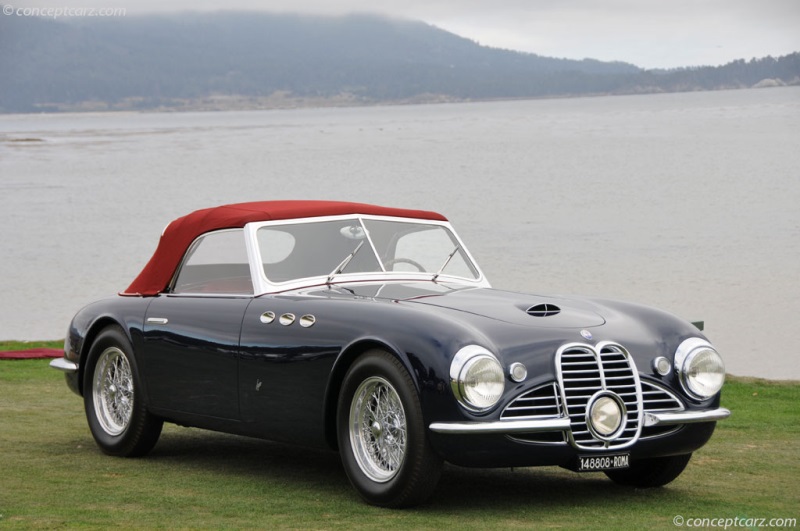1951 Maserati A6G 2000 Navigation
Maserati boasts a rich legacy in motorsport, a compelling aspect that led industrialist Adolfo Orsi to purchase the company in 1937. In the winter of 1939, the factory was moved to Modena, where work commenced on a road-going gran turismo. Ernesto Maserati was assigned the task of designing the upcoming A6 1500, which, after delays caused by the war, was finally revealed at the Geneva Motor Show in March 1947.The talent behind the Maserati company was the Maserati brothers who had signed a 10-year contract with Orsi, and when it expired in 1947, the brothers left and went on to form O.S.C.A. The ending of one era birth a new one, with the creation of the first Maserati road car, the A6. The 'A' in the name was in honor of Alfieri Maserati, and the '6' was for the straight-six engine.Maserati A6
The Maserati A6 series of racing and road-going automobiles cemented the company's legacy in the post-war era, successfully blending Italian style with advanced engineering. It showcased their ability to build stylish, high-performance automobiles that fused the company's racing heritage with modern technology and designs. During the mid-1940s, Ernesto Maserati worked with Alberto Massimino to create two racing prototype Barchettas known as the Tipo 6CS/46. Also known as the A6 Sport and A6CS, it was fitted with a 1,493cc (1.5 liter) straight-six engine sourced from the pre-war Maserati 6CM. Achieving success in racing, further development resulted in a two-seater sports racing car known as the A6GCS. It was completed in 1947 and powered by a 2-liter engine that initially developed 120 horsepower. Approximately fifteen examples of the A6GCS were built between 1947 and 1953. Maserati's First Production Road Car
The A6 1500 Gran Turismo was introduced in March 1947 at the Geneva Salon International de l'Auto and sixty-one examples were built through 1950. It featured a 1,488cc six-cylinder engine with a 66 mm bore, 72.5 mm stroke, a single overhead camshaft, and a Weber carburetor. Initially developing 65 horsepower, a version with higher compression, a modified camshaft, and three Weber carburetors boosted output to a more respectable figure of 90 bhp. A four-speed manual transmission directed power to the rear wheels.
Roadster by Frua
Chassis #: 2017
Engine #: 2013
View info and history
Auction entries : 1The tubular steel chassis had a wheelbase size of 100.4 inches, and its suspension included double wishbones at the front coil springs and Houdaille hydraulic dampers all round. Drum brakes were placed at all four corners. The Geneva show car wore two-door, two-seat coachwork with triple square portholes on its fully integrated front wings. The curvaceous bodywork was skillfully crafted by Pinin Farina, and many of the examples that followed were also clothed by the Italian coachbuilder. The first car was considered a prototype and had hidden headlamps; the production examples that followed had conventional headlamps. Early examples, including the prototype, had a three-window design, while later built examples had a second side window, and some even had 2+2 fastback configurations. Two convertibles were built by Pinin Farina with one being shown at the 1948 Salone dell'automobile di Torino. Chassis number 052 originally wore a Maserati-built 'barchetta' body but was later re-bodied by Zagato with a unique 'Panoramica' style coupe body. This was the first Maserati to receive coachwork from Zagato. A Larger Engine : The Maserati A6G 2000
Maserati's inaugural road vehicle did not manage to captivate audiences in the same manner as its racing cars had previously achieved. It was expensive, underpowered, and had conservative styling. Upon its arrival at the 1950 Turin Motor Show, Maserati anticipated that its newest model would address these challenges.
Roadster by Frua
Chassis #: 2017
Engine #: 2013
View info and history
Auction entries : 1With triple carburetors installed and a displacement size of 2.0 liters (1954.3cc), the engine developed upwards of 100 horsepower and could achieve speeds of around 180 km/h. Refinements to the chassis included a live rear axle with semi-elliptic leaf springs. Sixteen examples of the A6G 2000 were produced in 1950 and 1951, with nine being clothed by Pinin Farina in 2+2 fastback configurations. Vignale created one coupe to a design penned by Giovanni Michelotti, and Frua built one coupe and five convertibles. Maserati showcased three A6 vehicles at the Paris Auto Show in 1951: a Vignale Coupe, a Pinin Farina Berlinetta, and a Frua Spider. The A6GCS/53 and 54
The introduction of the A6GCS/53 in 1953 marked a significant enhancement in the performance capabilities of Maserati's road cars. With the option of twin overhead camshafts on the two-liter engine, engine output rose to 170 hp. It was installed in a tubular chassis that had a pair of large diameter side members, with smaller diameter sections adding reinforcement to the structure, and was suspended by double wishbones at the front and a live rear axle.
Roadster by Frua
Chassis #: 2017
Engine #: 2013
View info and history
Auction entries : 1Pinin Farina was now working with Ferrari, so design and construction of the coachwork was handled by Carrozzeria Fantuzzi or Celestino Fiandri of Carrozzeria Fiandri e Malagoli. Aldo Brovarone of Pinin Farina designed one spider, and Vignale also made a single spider. Two examples were bodied by Carrozzeria Frua in open-top configuration. Between 1953 and 1955, a total of 52 examples of the A6GCS/53 were built. The A6G/54 2000 was built from 1954 to 1956 with production totaling 60 cars.The engine powering the A6G/54 2000 had a twin-cam inline six-cylinder engine with 2 liters of displacement and fed by twin-choke Weber DCO carburetors. Dual ignition was added in 1956. 
Berlina by Pininfarina
Chassis #: AM2020
Engine #: 2020
View info and history
Auction entries : 1Between 1954 and 1956, a total of 60 examples of the A6G/54 were built with coachwork by Allemano, Zagato, and Frua with production nearly split evenly between the three. Frua made six coupes and twelve Grand Sport Spyders; Allemano bodied 21 coupes to a design created by Michelotti; and Zagato built a spider and 20 competition-oriented fastbacks. The A6 series were custom-bodied cars built for the road; its replacement, the 3500 GT, was a road-going car with (essentially) a production body. The 3500 GT was built in much higher quantities, with 2,226 examples constructed between 1957 and 1964. Beneath its bonnet was an all-new 3.5-liter long-stroke six-cylinder engine which had been developed for endurance racing. The coupe bodies were built by Carrozzeria Touring, and the Spyders by Vignale to a design by Giovanni Michelotti. The A6 series laid the foundation for the 3500 GT, which is considered the company's first successful series production Gran Turismo.
by Daniel Vaughan | Sep 2024
The Maserati A6 series of racing and road-going automobiles cemented the company's legacy in the post-war era, successfully blending Italian style with advanced engineering. It showcased their ability to build stylish, high-performance automobiles that fused the company's racing heritage with modern technology and designs. During the mid-1940s, Ernesto Maserati worked with Alberto Massimino to create two racing prototype Barchettas known as the Tipo 6CS/46. Also known as the A6 Sport and A6CS, it was fitted with a 1,493cc (1.5 liter) straight-six engine sourced from the pre-war Maserati 6CM. Achieving success in racing, further development resulted in a two-seater sports racing car known as the A6GCS. It was completed in 1947 and powered by a 2-liter engine that initially developed 120 horsepower. Approximately fifteen examples of the A6GCS were built between 1947 and 1953. Maserati's First Production Road Car
The A6 1500 Gran Turismo was introduced in March 1947 at the Geneva Salon International de l'Auto and sixty-one examples were built through 1950. It featured a 1,488cc six-cylinder engine with a 66 mm bore, 72.5 mm stroke, a single overhead camshaft, and a Weber carburetor. Initially developing 65 horsepower, a version with higher compression, a modified camshaft, and three Weber carburetors boosted output to a more respectable figure of 90 bhp. A four-speed manual transmission directed power to the rear wheels.
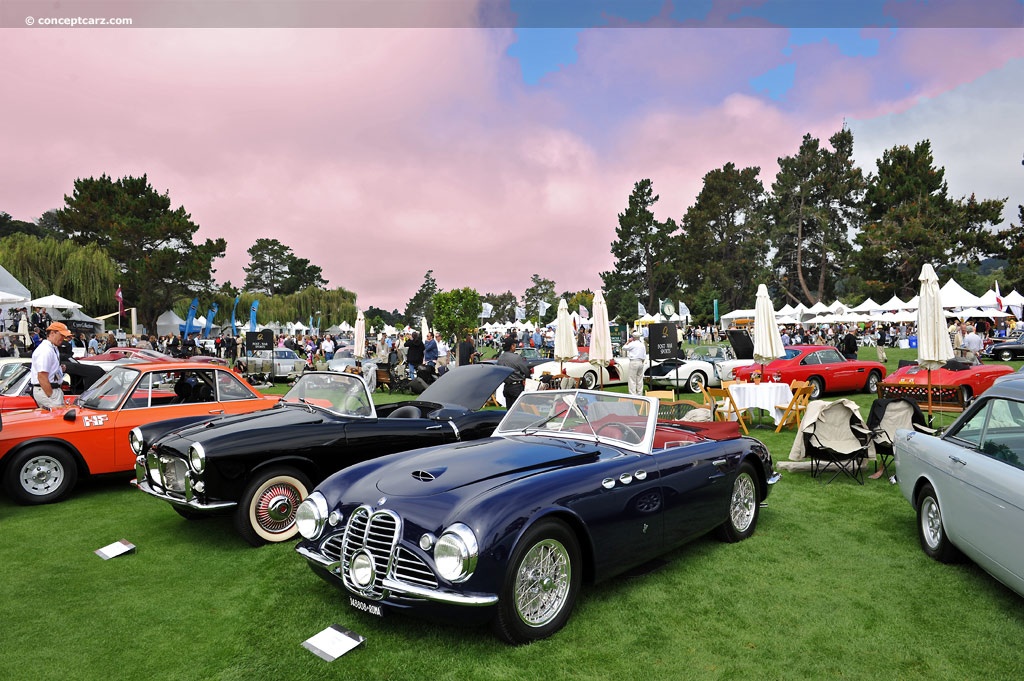
Roadster by Frua
Chassis #: 2017
Engine #: 2013
View info and history
Auction entries : 1
Maserati's inaugural road vehicle did not manage to captivate audiences in the same manner as its racing cars had previously achieved. It was expensive, underpowered, and had conservative styling. Upon its arrival at the 1950 Turin Motor Show, Maserati anticipated that its newest model would address these challenges.
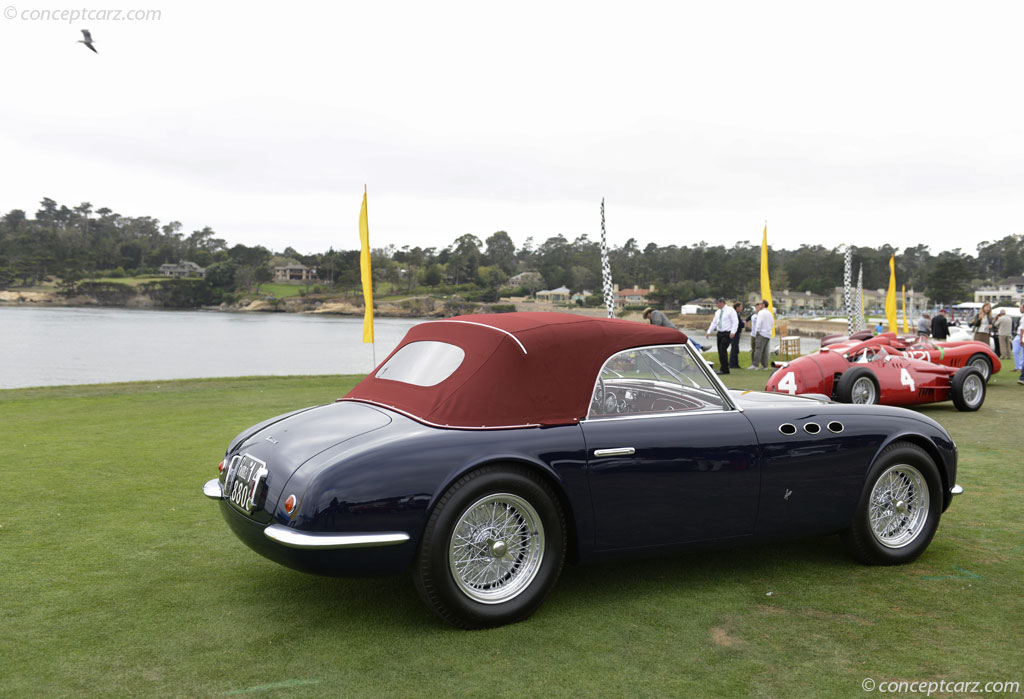
Roadster by Frua
Chassis #: 2017
Engine #: 2013
View info and history
Auction entries : 1
The introduction of the A6GCS/53 in 1953 marked a significant enhancement in the performance capabilities of Maserati's road cars. With the option of twin overhead camshafts on the two-liter engine, engine output rose to 170 hp. It was installed in a tubular chassis that had a pair of large diameter side members, with smaller diameter sections adding reinforcement to the structure, and was suspended by double wishbones at the front and a live rear axle.
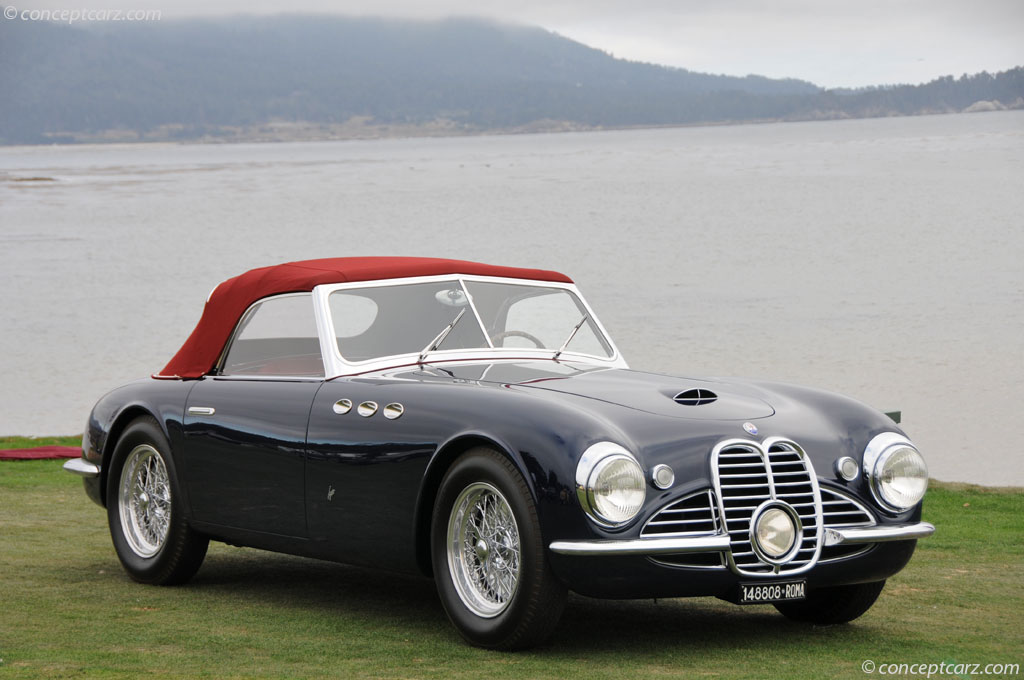
Roadster by Frua
Chassis #: 2017
Engine #: 2013
View info and history
Auction entries : 1
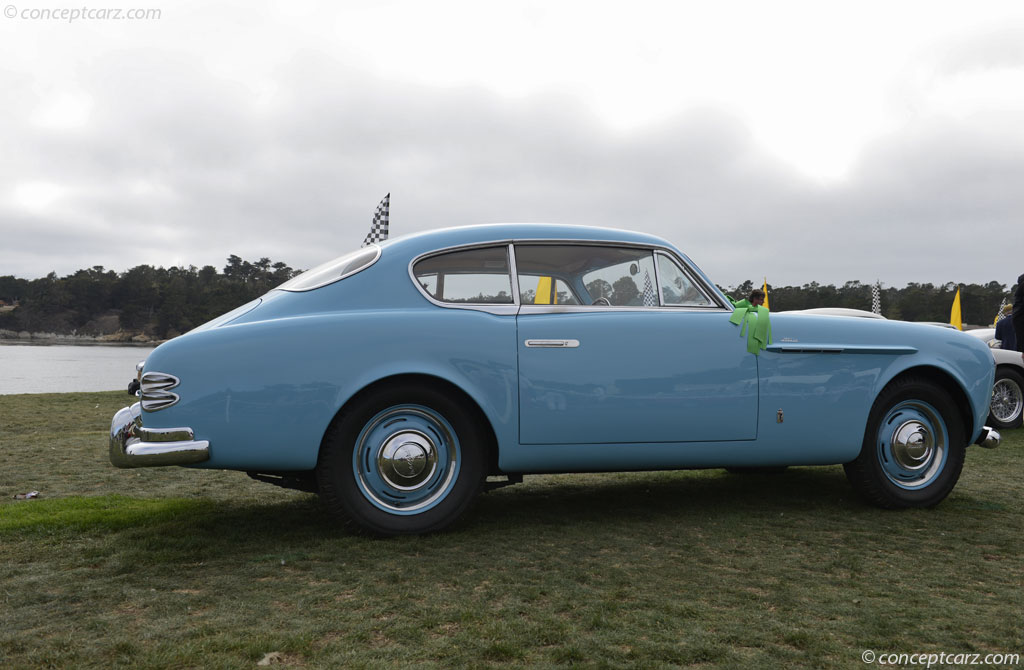
Berlina by Pininfarina
Chassis #: AM2020
Engine #: 2020
View info and history
Auction entries : 1
by Daniel Vaughan | Sep 2024
Related Reading : Maserati A6G History
The Maserati A6G2000 was produced from during the 1950s with around 60 examples being created, many receiving custom bodywork from prestigious coachbuilders such as Zagato, Pinin Farina, Vignale, and others. Even though the company was not in financial difficulty, the Maserati brothers sold their shares of the company to the Orsi family from Modena in 1937. The headquarters were moved from Bologna....
Continue Reading >>
Continue Reading >>
Related Reading : Maserati A6 History
Even though the company was not in financial difficulty, the Maserati brothers sold their shares of the company to the Orsi family from Modena in 1937. The headquarters were moved from Bologna to Modena. When they sold the company, the brothers had agreed to stay with Maserati for another ten years performing duties as chief engineers. In 1948, after their ten-year agreement was satisfied, they left....
Continue Reading >>
Continue Reading >>
- 1951 Maserati A6G 2000 Menu
- Article
- Image gallery
- Valuation
- Specifications
- Profiles
- Production figures
Maserati
Similar Automakers
Similarly Sized Vehicles
from 1951
1951 Maserati A6G 2000 Vehicle Profiles
Recent Vehicle Additions
Performance and Specification Comparison
A6G Specification Comparison by Year
Year
Production
Wheelbase
Engine
Prices
Related Automotive News

Preservation Bugatti Named Best of Show at the 73rd Pebble Beach Concours d'Elegance
2024 Charitable Donations Surpass %243 Million
For the first time in the history of the Pebble Beach Concours dElegance, Best of Show was awarded to a preservation car—a Bugatti Type 59.
This year, 214 cars from 16 countries and 29...

Geneva show cars to reclaim limelight at next month's Salon Privé Concours
Three rare pre-series Geneva show cars from the 1950s and 60s to be presented at Blenheim Palace
1951 Mercedes-Benz 300 S Cabriolet A show car represented the pinnacle of Stuttgarts production car range
1960 Maserati 3500 GT Spyder show car dis...

Alfa Romeo Named Best of Show at the 68th Pebble Beach Concours d'Elegance
Touring-Bodied Alfa Romeo 8C 2900B Named Best of Show at the 68th Pebble Beach Concours dElegance
PEBBLE BEACH, Calif. (August 26, 2018) — After an intense competition that drew diverse cars from around the globe, the coveted gold Best of Show...
Postwar Ferrari Named Best of Show at 2014 Pebble Beach Concours d'Elegance
1954 Ferrari 375 MM Scaglietti Coupe Named Best of Show
PEBBLE BEACH, Calif. (August 17, 2014) -- Excited cheers echoed across the 18th fairway of Pebble Beach Golf Links Sunday when a 1954 Ferrari 375 MM Scaglietti Coupe was named Best of...

Historic Jaguar D-Type Leads Growing List of Significant Entries for RM's Monterey Sale
RM Auctions building towards a spectacular roster of cars for its flagship Monterey sale held during the famous Pebble Beach Concours dElegance motoring week, August 16–17, in California
Historic 1955 Jaguar D-Type leads a superb roster of the...



























